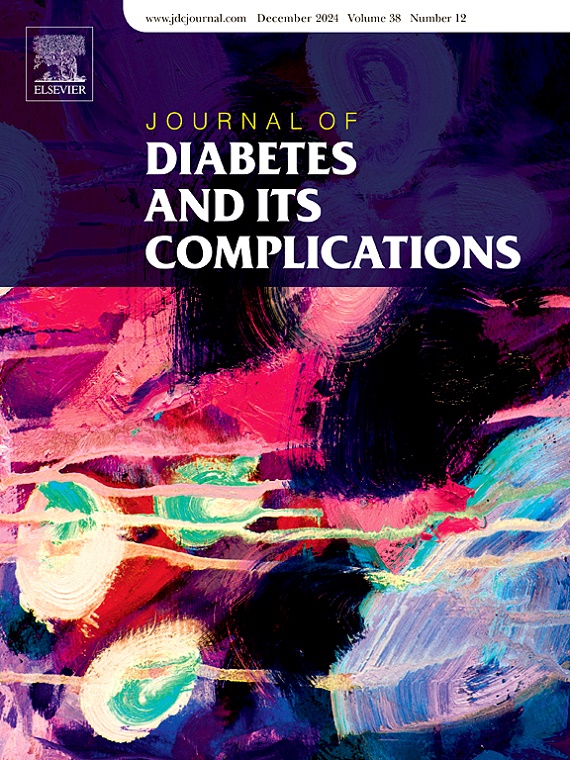Semaglutide, central retinal thickness and continuous glucose monitoring in persons with type 2 diabetes: A post-hoc analysis from a randomised trial
IF 3.1
3区 医学
Q3 ENDOCRINOLOGY & METABOLISM
引用次数: 0
Abstract
Aims
Glycemic control is important for preventing diabetic retinopathy (DR), but rapid improvements could deteriorate the disease. In some, but not all studies, semaglutide is speculated to worsen DR, but the mechanism is unknown. Central retinal thickness (CRT) is an early marker of DR. Therefore, the objective was to investigate whether increased Time in Range (TIR (3.9–10.0 mmol/L)), was associated with reduced CRT in persons treated with semaglutide.
Methods
Forty participants with type 2 diabetes were included in this post-hoc analysis of a 32-week randomised, placebo-controlled, partly open-label trial investigating the separate and combined effects of semaglutide and empagliflozin on target organ damage in 120 participants with type 2 diabetes. Individuals were randomised into four groups: i) semaglutide, ii) empagliflozin, iii) the combination or iv) placebo, n = 30 for each group). In the present study, 10 participants from each of the 4 arms participated. TIR was assessed using Continuous Glucose Measurement for 7–8 days and CRT was assessed using ocular coherence tomography.
Results
In the 10 individuals treated with semaglutide, CRT increased ~1 % (3.76 μm, 95%CI [−0.32; 7.85], p = 0.065) compared to placebo. This was attenuated with adjustment for TIR (p = 0.21).
Independently of the four interventions, increased TIR remained associated with increased CRT (0.07 μm, 95%CI[0.03; 0.12]μm, p = 0.002).
Conclusion
Semaglutide treatment did not impact CRT beyond what could be explained by changes in glycaemia. Across all interventions, increased TIR was associated with increases in CRT, thus supporting the link between rapid improved glycemia and DR.
2型糖尿病患者的西马鲁肽、中央视网膜厚度和连续血糖监测:一项随机试验的事后分析
目的血糖控制对预防糖尿病视网膜病变(DR)很重要,但快速改善可能会使疾病恶化。在一些但不是所有的研究中,推测西马鲁肽会加重DR,但其机制尚不清楚。中央视网膜厚度(CRT)是dr的早期标志,因此,目的是研究在接受西马鲁肽治疗的患者中,视网膜厚度范围(TIR (3.9-10.0 mmol/L))增加是否与CRT降低有关。方法:40名2型糖尿病患者参与了一项为期32周的随机、安慰剂对照、部分开放标签试验的事后分析,研究了西马鲁肽和恩格列净对120名2型糖尿病患者靶器官损伤的单独和联合作用。个体被随机分为四组:i) semaglutide, ii) empagliflozin, iii)联合用药或iv)安慰剂,每组n = 30)。在本研究中,四组各有10名参与者参与。连续血糖测量7-8天评估TIR,眼相干断层扫描评估CRT。结果西马鲁肽治疗10例患者,CRT升高~ 1% (3.76 μm), 95%CI [- 0.32;7.85], p = 0.065)。调整TIR后,这种情况减弱(p = 0.21)。独立于四种干预措施,增加的TIR仍然与增加的CRT相关(0.07 μm, 95%CI[0.03;0.12]μm, p = 0.002)。结论西马鲁肽治疗对CRT的影响不超过血糖的改变。在所有干预措施中,TIR的增加与CRT的增加相关,从而支持血糖的快速改善与DR之间的联系。
本文章由计算机程序翻译,如有差异,请以英文原文为准。
求助全文
约1分钟内获得全文
求助全文
来源期刊

Journal of diabetes and its complications
医学-内分泌学与代谢
CiteScore
5.90
自引率
3.30%
发文量
153
审稿时长
16 days
期刊介绍:
Journal of Diabetes and Its Complications (JDC) is a journal for health care practitioners and researchers, that publishes original research about the pathogenesis, diagnosis and management of diabetes mellitus and its complications. JDC also publishes articles on physiological and molecular aspects of glucose homeostasis.
The primary purpose of JDC is to act as a source of information usable by diabetes practitioners and researchers to increase their knowledge about mechanisms of diabetes and complications development, and promote better management of people with diabetes who are at risk for those complications.
Manuscripts submitted to JDC can report any aspect of basic, translational or clinical research as well as epidemiology. Topics can range broadly from early prediabetes to late-stage complicated diabetes. Topics relevant to basic/translational reports include pancreatic islet dysfunction and insulin resistance, altered adipose tissue function in diabetes, altered neuronal control of glucose homeostasis and mechanisms of drug action. Topics relevant to diabetic complications include diabetic retinopathy, neuropathy and nephropathy; peripheral vascular disease and coronary heart disease; gastrointestinal disorders, renal failure and impotence; and hypertension and hyperlipidemia.
 求助内容:
求助内容: 应助结果提醒方式:
应助结果提醒方式:


